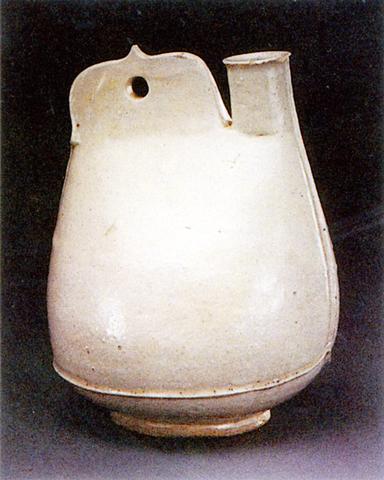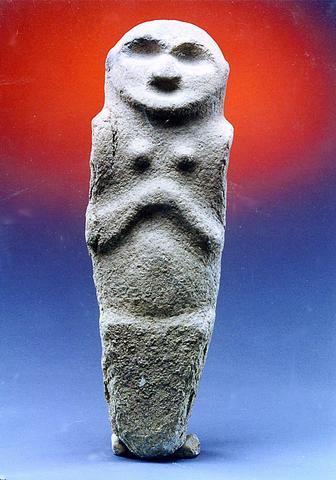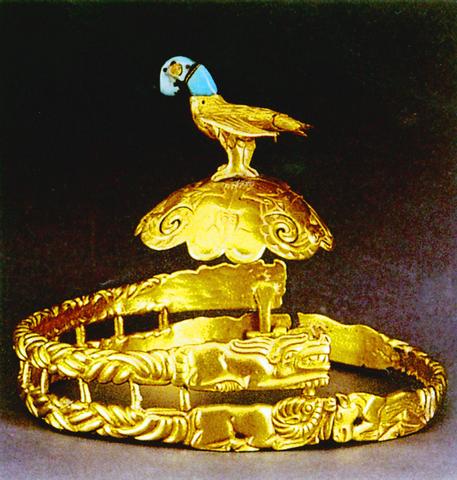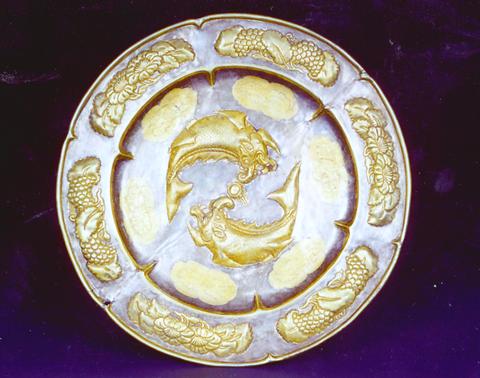This large-scale retrospective exhibition, focusing on the culture of one ethnic Chinese region, features 400 artifacts on loan from almost 30 museums in northern China.
The works span from the Neolithic Period to the Ching dynasty and represent a number of ethnic subgroups in northern China, in areas located mostly in current-day Inner Mongolia. Cultural relics from the region include ornaments in gold, silver, bronze and jade; costumes; stoneware; sculpture; and daily utensils made from bronze, porcelain, pottery and copper.
The nomadic cultures of the steppe region that survived for thousands of years are distinct from the agricultural interior of China, south of the Great Wall.

PHOTO COURTESY: NATIONAL PALACE MUSEUM
"For people with a romantic disposition, the ever-stretching steppe is just like the vast expanse of the ocean, full of imaginative allure," says Tu Cheng-sheng (杜正勝), director of the National Palace Museum, where the show is taking place. Tu adds that Inner Mongolia is significant as a good example of an ethnic melting pot and the artifacts on view are solid testimony to this point.
The civilizations of each ethnic subgroup in northern China are showcased in the various sections of the exhibition. The general term of Chinese is said to consist of seven ethnic groups: Han, the majority, and the minority groups of Man, Mongolians, Hui, Tibetans, Miao and Yao. However, more sub-ethnic groups emerged over history, eventually making up the huge population of the ethnic group known as Chinese. Inner Mongolia, for example, has been inhabited by seven ethnic subgroups: Tunghu (東胡), Hsiungnu (匈奴), Wuhuan (烏桓), Hsien-pei (鮮卑), Tu-chuen (突厥), Khitan (契丹), and Mongols (蒙古).
Upon entering the exhibition, there are four sections to the right and left. In the first section on the right are artifacts from the earliest period, dubbed the Pre-Nomadic Period (80th to 16th century BC).

PHOTO COURTESY: NATIONAL PALACE MUSEUM
Artifacts from this period include jade pieces and sculptures of humans and folk gods. The jade wares originate from the so-called Red Mountain Civilization (紅山文化) of about 5000 to 6000 years ago and reveal sophisticated designs and workmanship. Among the favorites is the pig-dragon jade piece (玉豬龍). A red clay sculpture of a female deity from this period on display is distinctive for its obscured facial and body features -- a departure from sculpture in earlier periods that emphasized female breasts and buttocks.
The subsequent period marked the beginning of the nomadic lifestyle by the Tunghu people. The artifacts from this period are dubbed "animal style," as animal themes dominated this group's cultural and artistic creations. Bronze swords or daggers inscribed with simple, classic and elegant animal totems are the featured relics from this period, particularly from the excavation sites dubbed "Upper-Hsia-chia Civilization" (夏家店上層文化).
The exhibitions to the left of the entrance, marked by a blue banner, are relics from the Hsiungnu tribe, a civilization formed in 206 BC. The Hsiungnu are known as a horse-riding, animal-hunting people with a fierce fighting spirit. They created a unique nomadic culture with the Tunghu people which had a major impact on horse-riding tribes.

PHOTO COURTESY: NATIONAL PALACE MUSEUM
The central artifact in this exhibit is a hawk-shaped gold hat ornament supposedly worn by the Hsiungnu king. Animal symbols, each topped by a colored hawk, emphasize the power and vigor of the king.
The Hsien-pei and Tu-chueh tribes occupied the vast land of the northern steppe from the 4th to the 10th centuries. Hsien-pei people built the empire of Northern Wei and their cultural relics have a strong animal-theme. Different from the preceding Hsiungnu artifacts are the gold ornaments of horse heads with deer antlers. The Tu-chueh people's domain was bordered by the powerful Tang empire to the south, bringing influences from far away places in neighboring China. Some of the examples in the show include a gold and silver plate with an exotic fish pattern that is said to be of Indian mythological animals and a silver pot capped with the figure of a human head, suggesting a Persian influence.
The Khitan people established the Liao Empire in 907 AD, which lasted until the early 13th century. They left behind a rich heritage as witnessed in the saddlery, gold and silver vessels and porcelain wares on view at the exhibition. The most representative items from this period are the cockscomb flasks and liquid containers that functioned as canteens for the nomads.

PHOTO COURTESY: NATIONAL PALACE MUSEUM
The show also features a large section on Mongolian culture. The Mongolian emperor Genghis Khan (1162-1227) conquered the region in the early 13th century, establishing a base from which he created a vast empire spanning Europe and Asia. His reign left behind spectacular multi-cultural relics, some of which are on exhibit. Featured in this section are Buddhist sculptures, gold items, musical instruments, and porcelain pieces tinged heavily with Tibetan and Islamic elements. Chinese porcelain ware from inland China that turned up in Inner Mongolia, a sign of flourishing trade at the time, are also on exhibit. Also not to be missed in this section are the pottery figurines and saddlery.

Nov. 11 to Nov. 17 People may call Taipei a “living hell for pedestrians,” but back in the 1960s and 1970s, citizens were even discouraged from crossing major roads on foot. And there weren’t crosswalks or pedestrian signals at busy intersections. A 1978 editorial in the China Times (中國時報) reflected the government’s car-centric attitude: “Pedestrians too often risk their lives to compete with vehicles over road use instead of using an overpass. If they get hit by a car, who can they blame?” Taipei’s car traffic was growing exponentially during the 1960s, and along with it the frequency of accidents. The policy

What first caught my eye when I entered the 921 Earthquake Museum was a yellow band running at an angle across the floor toward a pile of exposed soil. This marks the line where, in the early morning hours of Sept. 21, 1999, a massive magnitude 7.3 earthquake raised the earth over two meters along one side of the Chelungpu Fault (車籠埔斷層). The museum’s first gallery, named after this fault, takes visitors on a journey along its length, from the spot right in front of them, where the uplift is visible in the exposed soil, all the way to the farthest

While Americans face the upcoming second Donald Trump presidency with bright optimism/existential dread in Taiwan there are also varying opinions on what the impact will be here. Regardless of what one thinks of Trump personally and his first administration, US-Taiwan relations blossomed. Relative to the previous Obama administration, arms sales rocketed from US$14 billion during Obama’s eight years to US$18 billion in four years under Trump. High-profile visits by administration officials, bipartisan Congressional delegations, more and higher-level government-to-government direct contacts were all increased under Trump, setting the stage and example for the Biden administration to follow. However, Trump administration secretary

The room glows vibrant pink, the floor flooded with hundreds of tiny pink marbles. As I approach the two chairs and a plush baroque sofa of matching fuchsia, what at first appears to be a scene of domestic bliss reveals itself to be anything but as gnarled metal nails and sharp spikes protrude from the cushions. An eerie cutout of a woman recoils into the armrest. This mixed-media installation captures generations of female anguish in Yun Suknam’s native South Korea, reflecting her observations and lived experience of the subjugated and serviceable housewife. The marbles are the mother’s sweat and tears,